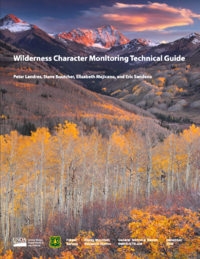USFS Wilderness Character Monitoring Technical Guide
- Abbreviations and Acronyms
- Part 1, National Framework, describes what and why, i.e., the approach the Forest Service will use to implement wilderness character monitoring nationwide, including definitions and key concepts.
- Wilderness Character Monitoring in the Forest Service
- Untrammeled Quality
- Natural Quality
- Undeveloped Quality
- Solitude or Primitive and Unconfined Recreation Quality
- Other Features of Value Quality
- Part 2, Monitoring Protocols, describes how this monitoring will be implemented with detailed, step-by-step protocols.
- Overview
- Untrammeled Quality Indicators
- Natural Quality Indicators
- Undeveloped Quality Indicators
- Solitude or Primitive and Unconfined Recreation Quality Indicators
- Other Features of Value Quality Indicators
- Glossary
- References
- Appendices
This Wilderness Character Monitoring Technical Guide provides a tested and refined methodology for monitoring trends in wilderness character based on lessons learned from 15 years of experience developing and implementing wilderness character monitoring across the National Wilderness Preservation System. This document updates and replaces the Technical Guide for Monitoring Selected Conditions Related to Wilderness Character (Landres et al. 2009), and provides protocols for the Forest Service, U.S. Department of Agriculture, to implement a nationally consistent approach to wilderness character monitoring across all 448 wildernesses administered by the agency. This approach also is consistent with the interagency wilderness character monitoring strategy published in Keeping It Wild 2: An Updated Interagency Strategy to Monitor Trends in Wilderness Character Across the National Wilderness Preservation System (Landres et al. 2015) and endorsed in 2015 by the Interagency Wilderness Policy Council.
This technical guide builds on the best available data to yield a coherent understanding of how wilderness character is changing over time. Wilderness character monitoring provides the Forest Service:
- Information to show how agency stewardship makes a difference on the ground based on credible data that are collected consistently and endure over time.
- Accountability for the legal and policy mandate "to preserve wilderness character" by compiling key data to evaluate trends in conditions that tie directly to the Wilderness Act of 1964.
- A communication framework to comprehensively discuss wilderness stewardship needs and priorities related to preserving wilderness character within the Forest Service and with the public.
Wilderness character monitoring in the Forest Service is designed to be nationally consistent while allowing and encouraging local flexibility as necessary to meet wilderness-specific needs. The statutory language of the Wilderness Act is used to identify five qualities of wilderness character that form the foundation of this monitoring: (1) Untrammeled, (2) Natural, (3) Undeveloped, (4) Solitude or Primitive and Unconfined Recreation, and (5) Other Features of Value. This technical guide uses Keeping It Wild 2’s organizational framework of qualities, monitoring questions, and indicators to ensure consistency across the four wilderness managing agencies (the Forest Service, the National Park Service, the Bureau of Land Management, and the U.S. Fish and Wildlife Service). Each agency identifies measures to evaluate trends in these five qualities. This technical guide describes the Forest Service required as well as optional measures. Locally developed measures to meet wilderness-specific information needs are also discussed.
Implementing wilderness character monitoring does not guarantee the preservation of wilderness character, but it informs and helps improve wilderness stewardship by ensuring that Forest Service line officers and managers are accountable to the central mandate of the Wilderness Act—to preserve wilderness character.
